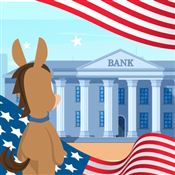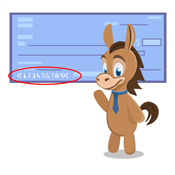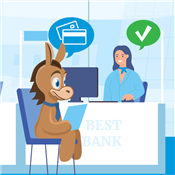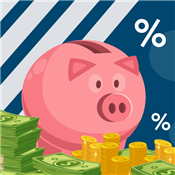U.S. Bank Routing Number
To transfer money in or out of your U.S. Bank checking or savings account, you'll need the right routing number. Find your U.S. Bank routing number below.
Routing numbers are 9-digit numbers that banks use to identify themselves. Think of them as an address that lets other banks know where to find your money.
You need your routing number for many tasks, including:
- ACH payments
- Setting up direct deposit
- Receiving benefits from the government, including tax refunds
- Transferring money between accounts at different banks or investment firms
- Automatic bill payment
- Wire transfers
Banks typically have more than one routing number if they have branches in more than one state. U.S. Bank has branches throughout the United States and uses different routing numbers for different states and regions.
Keep reading to find the right U.S. Bank routing number for your transactions.
Do U.S. Bank Routing Numbers Ever Change?
Your U.S. Bank routing number is associated with the location of the bank where you opened your account. Even if you bank at another branch, what matters is the location where you opened your account.
Here are the U.S. Bank routing numbers by state:[1]
| State | Routing Number |
|---|---|
| Arizona | 122105155 |
| Arkansas | 082000549 |
| California - Northern | 121122676 |
| California - Southern | 122235821 |
| Colorado - Aspen | 102101645 |
| Colorado - all other areas | 102000021 |
| Idaho | 123103729 |
| Illinois - Northern | 071904779 |
| Illinois - Southern | 081202759 |
| Indiana | 074900783 |
| Iowa - Council Bluffs | 104000029 |
| Iowa - all other areas | 073000545 |
| Kansas | 101000187 |
| Kentucky - Northern | 042100175 |
| Kentucky - Western | 083900363 |
| Minnesota - East Grand Forks | 091215927 |
| Minnesota - Moorhead | 091300023 |
| Minnesota - all other areas | 091000022 |
| Missouri | 081000210 |
| Missouri - Western | 101200453 |
| Montana | 092900383 |
| Nebraska (+ Council Bluffs, IA) | 104000029 |
| Nevada | 121201694 |
| New Mexico | 107002312 |
| North Carolina | 064103707 |
| North Dakota (+ Moorhead, MN) | 091300023 |
| Ohio - Cleveland | 041202582 |
| Ohio - all other areas | 042000013 |
| Oregon | 123000220 |
| South Dakota | 091408501 |
| Tennessee | 064000059 |
| Utah | 124302150 |
| Washington | 125000105 |
| Wisconsin | 075000022 |
| Wyoming | 307070115 |
| All other states | 091000022 |
If you don't see your area or state listed or are unsure where you opened your account, read on for other ways to find your routing number.
The first four digits pertain to the Federal Reserve. The next four are unique to your bank, basically the bank's address for the Federal Reserve. The final digit is a mathematical calculation of the first eight digits—it's used to prevent fraud.
Routing Numbers for Domestic/International Wire Transfers
Wire transfers are a faster way to send money than an ACH transfer. From your U.S. Bank account, you can wire money to other bank accounts, and other accounts can wire funds to you.
Receiving Domestic/International Wire Transfers
Use the routing number associated with your account's U.S. Bank branch location from the list above.
U.S. Bank
800 Nicollet Mall
Minneapolis, MN 55402
Sending Domestic Wire Transfers
Visit a branch location and bring a valid ID. You'll need your routing and account numbers, plus:
- Recipient's name as it appears on the account
- Location of the recipient's bank (including city and state)
- Account number
- Bank routing number
- Incoming (Domestic): $20.00
- Outgoing (Domestic): $30.00
- Incoming (International): $25.00
- Outgoing (International): $50.00
Sending International Wire Transfers
Visit a branch location and bring a valid ID. Use the U.S. Bank SWIFT code USBKUS44IMT.
SWIFT codes are the international equivalents of the U.S. routing numbers. They direct the money to the correct bank for international transfers.
You'll also need:
- Recipient's name as it appears on the account
- Recipient bank name, address, and country
- Recipient account number (you may need a country-specific account structure, e.g., a CLABE for Mexico or an IBAN for international bank accounts)
- Recipient bank's SWIFT code
- Currency of recipient's account (foreign currency or U.S. dollars)
- Purpose of wire
Which U.S. Bank Routing Number Should You Use?
For any domestic money transfer activity:
Use the routing number for the branch where you opened your account.
For domestic wire transfers:
Use the routing number for the branch where you opened your account.
For international wire transfers:
Use the U.S. Bank SWIFT code USBKUS44IMT.
Other Ways to Find Your U.S. Bank Routing Number
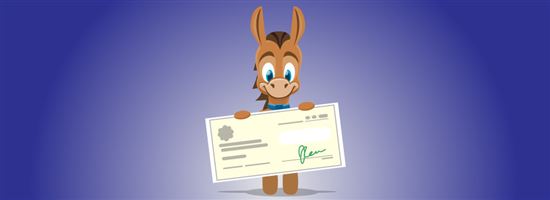 |
| © CreditDonkey |
Here are several other ways to find your U.S. Bank routing number:
Use a Check
For checking accounts, you can find the routing number on the bottom of checks corresponding to your checking account. It's the 9 digits located at the bottom left of the check.
Go Online
Log onto the U.S. Bank website. Then select the applicable account. In the top box, you'll find your account number and routing number.
Call Customer Service
Call U.S. Bank at 800-872-2657. After you provide a few specific details to identify yourself, a representative will be able to confirm your account's routing number.
Although your debit card is associated with a bank account, you do not use a routing number for debit card transactions. Routing numbers are only used for transfers directly between bank accounts.
Likewise, credit cards do not have routing numbers since they are not directly linked to any bank account. When you pay your credit card online, you may need to use your bank account routing number to set up the link between your credit card account and checking account, like you would for any other bill.
Other Ways to Transfer Money with U.S. Bank
Nowadays, you can transfer money without having to leave home. Here are other ways to transfer money with U.S. Bank.
Zelle
To send money with Zelle, all you need is an email address or a phone number. There's no need for the recipient's account number, and you can send money domestically within minutes. Just click the built-in Zelle icon in the app, and then send money.
Online Transfers
Another option you have is transferring directly from your U.S. Bank account. You can transfer internally, to your accounts, other U.S. Bank accounts, or externally to other banks.
- Online Banking: Log in and go to Pay Bills & Transfer > Transfer Money.
- App: Log in and go to Transfers > Transfer money.
Wire Transfers
If you need to send larger amounts of money domestically, you can utilize U.S. Bank's send wire transfer feature on the app or through online banking. [4]
- Online Banking: Log in and go to Transfer, deposit & Pay > External transfers & wires > Send wire.
- App: Log in and go to Pay bills & transfer > External transfers, wires, & ACH > Wire money.
In most cases, bank-to-bank wire transfers are delivered within 24 hours.
Bottom Line
You'll likely need your U.S. Bank routing number when managing your finances. Keep it handy should you need to set up a direct deposit, automatic payment, or wire transfer.
References
- ^ U.S. Bank. Routing Numbers, Retrieved 03/26/2024
- ^ U.S. Bank. How do I receive a wire transfer?, Retrieved 03/26/2024
- ^ U.S. Bank. How much does a wire transfer cost?, Retrieved 03/26/2024
- ^ U.S. Bank. How do I send a wire transfer?, Retrieved 03/26/2024
U.S. Bank Business Essentials - $400 Bonus
Promo code Q4AFL25 MUST be used when opening a U.S. Bank Business Essentials®, or Platinum Business Checking account. Limit of one bonus per business. A $100 minimum deposit is required to open one of the referenced accounts.
Earn your $400 Business Checking bonus by opening a new U.S. Bank Business Essentials account between 10/01/2025 and 1/14/2026. You must make deposit(s) of at least $5,000 in new money within 30 days of account opening and thereafter maintain a daily balance of at least $5,000 until the 60th day after account opening. You must also complete 5 qualifying transactions within 60 days of account opening.
Qualifying transactions include debit card purchases, ACH credits, Wire Transfer credits and debits, Zelle credits and debits, U.S. Bank Mobile Check Deposit or Bill Pay or payment received via U.S. Bank Payment Solutions. Other transactions such as (but not limited to) other Person to Person payments, transfers to credit card or transfers between U.S. Bank accounts are not eligible.
New money is considered money that is new to U.S. Bank. Funds must come from outside U.S. Bank and cannot be transferred from another U.S. Bank product or a U.S. Bank Affiliate. For accounts opened on non-business days, weekends or federal holidays, the open date is considered the next business day. Account fees (e.g., monthly maintenance, paper statement fee, etc.) could reduce the qualifying daily balance, therefore you must make deposit(s) to cover the fees to maintain the daily balance during the qualifying period to be awarded the bonus. Refer to the Business Pricing Information or Business Essentials Pricing Information Document for a list of fees.
Bonus will be deposited into your new eligible U.S. Bank Business Checking account within 30 days following the last calendar day of the month you complete all of the offer requirements, as long as the account is open and has a positive available balance.
Offer may not be combined with any other business checking account bonus offers. Existing customers (businesses) with a business checking account or customers (businesses) who had an account in the last 12 months, do not qualify.
All regular account-opening procedures apply. For a comprehensive list of checking account pricing, terms and policies, reference your Business Pricing Information or Business Essentials Pricing Information and YDAA disclosure. These documents can be obtained by contacting a U.S. Bank branch or calling 800.872.2657.
Bonus will be reported as interest earned on IRS Form 1099-INT and recipient is responsible for any applicable taxes. Current U.S. Bank employees are not eligible. U.S. Bank reserves the right to withdraw this offer at any time without notice. Member FDIC
Bank of America Advantage Banking - Up to $500 Cash Offer
- The cash offer up to $500 is an online only offer and must be opened through the Bank of America promotional page.
- The offer is for new checking customers only.
- Offer expires 1/31/2026.
- To qualify, open a new eligible Bank of America Advantage Banking account through the promotional page and set up and receive Qualifying Direct Deposits* into that new eligible account within 90 days of account opening. Your cash bonus amount will be based on the total amount of your Qualifying Direct Deposits received in the first 90 days.
Cash Bonus Total Qualifying Direct Deposits $100 $2,000 $300 $5,000 $500 $10,000+ - If all requirements are met 90 days after account opening, Bank of America will attempt to deposit your bonus into your new eligible account within 60 days.
- Bank of America Advantage SafeBalance Banking® for Family Banking accounts are not eligible for this offer.
- Additional terms and conditions apply. See offer page for more details.
- *A Qualifying Direct Deposit is a direct deposit of regular monthly income – such as your salary, pension or Social Security benefits, which are made by your employer or other payer – using account and routing numbers that you provide to them.
- Bank of America, N.A. Member FDIC.
Wells Fargo Everyday Checking Account - $325 Bonus
- Get a $325 new checking customer bonus when you open an Everyday Checking account and receive $1,000 or more in qualifying direct deposits.
- Wells Fargo Bank, N.A.
Member FDIC
CIT Bank Platinum Savings - $300 Bonus
- Qualify for a $300 cash bonus with a minimum deposit of $50,000
- This limited time offer to qualify for a $225 cash bonus with a minimum deposit of $25,000 or a $300 bonus with a minimum deposit of $50,000 is available to New and Existing Customers who meet the Platinum Savings promotion criteria. The Promotion begins on September 23, 2025 and can end at any time without notice.
Free Business Checking - Earn $500 Bonus
To earn the $500 bonus, customers must apply for a Bluevine Business Checking account anytime between now and 01/31/2026 using the referral code CD500.
After opening your account, deposit a total of $5,000 within the first 30 days. After 30 days, maintain a minimum daily balance of $5,000 while also completing at least one of the following eligibility requirements every 30 days for 90 days:
- Deposit at least $5,000 from eligible merchant services to your Bluevine account OR
- Make at least $5,000 of outbound payroll payments from your Bluevine account using eligible payroll providers OR
- Spend at least $2,000 on eligible transactions with your Bluevine Business Debit Mastercard® and/or Bluevine Business Cashback Mastercard®
Banking services provided by Coastal Community Bank, Member FDIC
Write to Andres S at feedback@creditdonkey.com. Follow us on Twitter and Facebook for our latest posts.
Note: This website is made possible through financial relationships with some of the products and services mentioned on this site. We may receive compensation if you shop through links in our content. You do not have to use our links, but you help support CreditDonkey if you do.
|
|
| ||||||
|
|
|
Compare:





